Peugeot to unveil its all new electric e-Vivacity scooter
by: Ecofriend, 2011-04-05 11:35:32 UTC
Dattatreya:

It has been long since Peugeot introduced its first electric scooter in the form of Scoot’elec. Back then, it was powered by nickel-cadmium batteries. But now, as the paradigm has shifted to an enhanced level of sustainability, Peugeout is all set to introduce its all new and advanced electric scooter. Named as the e-Vivacity, it is powered by a sturdy lithium-ion battery pack from manufacturer Saft.
Marketed towards urban commuting, the petite e-Vivacity has a range of around 60 miles and a top speed of 28 miles per hour. It can be charged in less than four hours using a standard European 230-volt plug, while after just two hours, the scooter can get an 80 percent efficient charge.
But the defining factor of this bantam vehicle will be its cost effectiveness, especially from the perspective of fuel consumption. Its 4 KW motor is comparable to that of a petrol fueled 50 cc scooter. Taking that into account now it is just a matter of simple mathematics. An average scooter travels 2,485 miles a year, and the e-Vivacity can cover that amount of distance for the meager cost of only $22.67! This, according to the company, is just about one-tenth of the conventional cost incurred by its gas guzzling cousins. But other than the criterion of fuel consumption, Peugeot has not yet released the overall pricing of this conveniently conceived vehicle.
Source: AutoBlog


 City Compost Bin
City Compost Bin
by: Yanko Design, 2011-04-04 15:13:44 UTC
Composting is an important, vital part to creating a sustainable city but few urbanites engage in the activity because of stigmas. The idea of having a heap of organic trash slowly decomposing away inside a hot box doesn’t seem very sanitary but to change that perception, the C/N concept aesthetically improves the appearance and ease of use of city compositing bins.
The bins don’t require the public to significantly modify their behavior. You still walk up to a trash bin and dump organic matter. A city attendant then rotates the bins depending on the level of decomposition into finally, a rich nutrient soil far superior to the current chemically fertilized dirt found in most cities.
Designer: Mathieu Azema
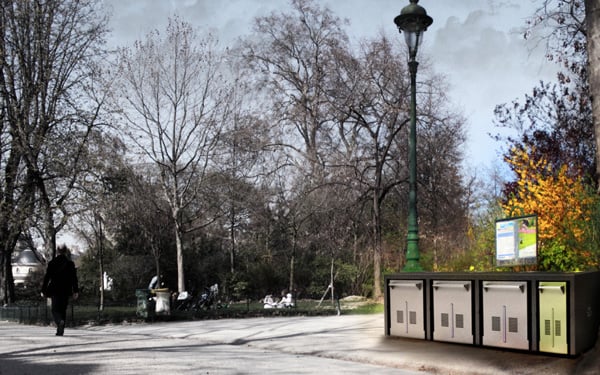
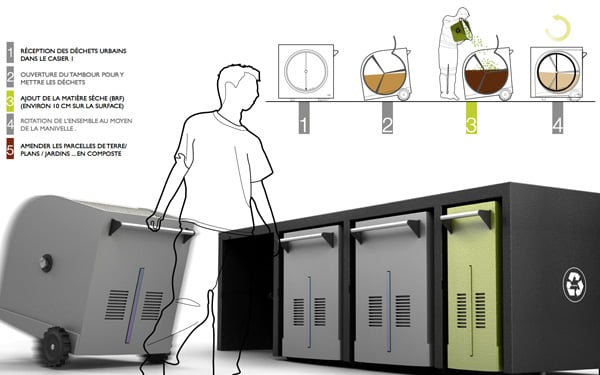
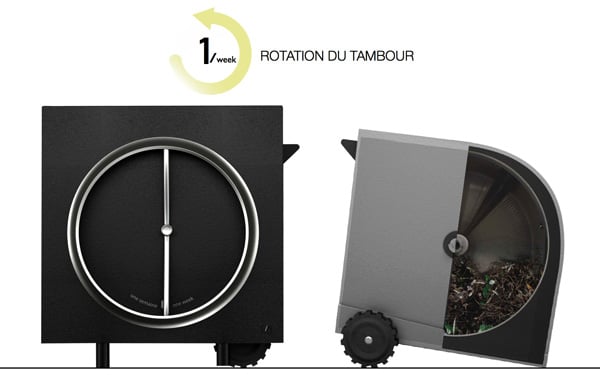
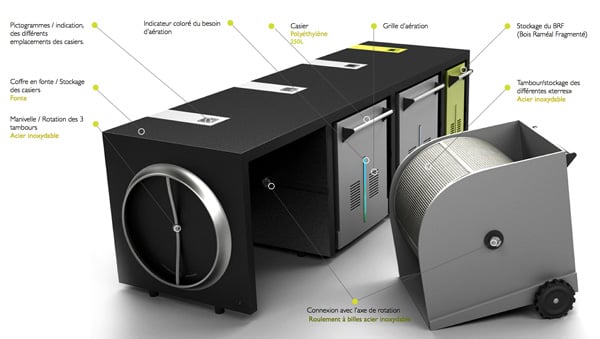
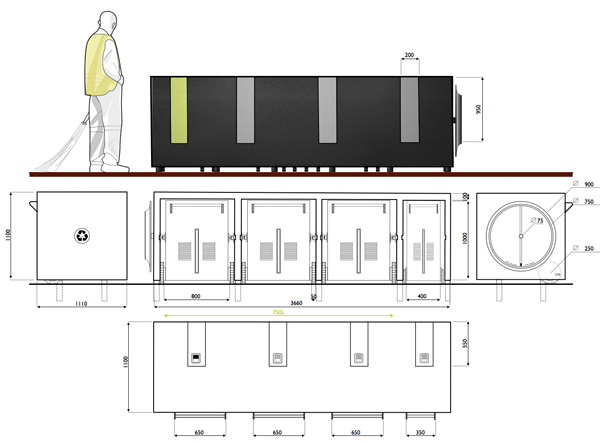
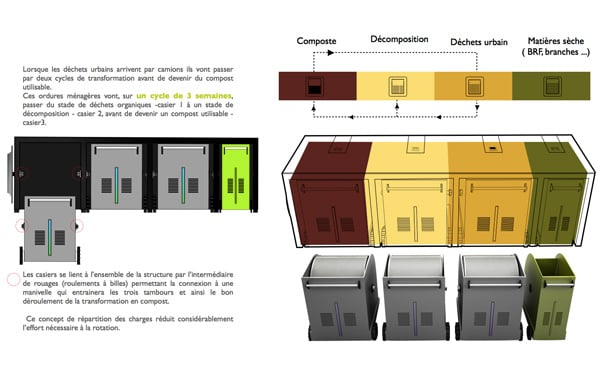
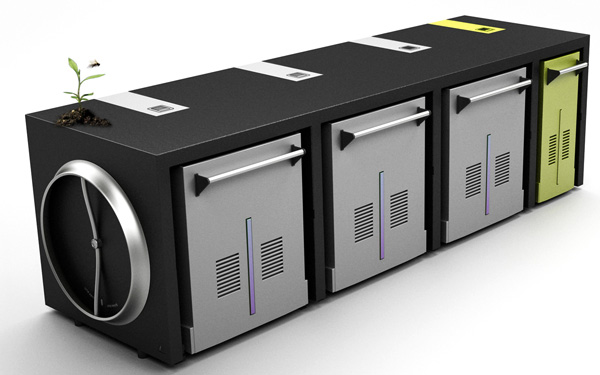
----------
Yanko Design
Timeless Designs - Explore wonderful concepts from around the world!
Yanko Design Store - We are about more than just concepts. See what's hot at the YD Store!
Waste Chicken Feathers Make Durable, Biodegradable Plastic
by: Eco Geek Latest, 2011-04-05 18:31:21 UTC

Chicken feathers, as unlikely as it seems, have turned out to be a wonderfully useful material. Among other things, researchers have found they make for great circuit boards and cheap, efficient storage tanks for hydrogen. Now it turns out they could also be used to create biodegradable, petroleum-free plastics.
Researchers at the University of Nebraska-Lincoln say that the protein keratin in chicken feathers, which is strong and durable, as well as the fact that so many of them end up as unused waste, is what makes them such an appealing material. When making the plastic, the scientists heat-treated the feathers to clean them and then pulverized them into a fine powder. They then added chemicals that made the keratin molecules join together into long chains and create a polymer.
The resulting plastic was stronger than other bioplastics made of soy beans or starch and it stood up to water. The material is a thermoplastic which means that heat can be used to mold it into various products and can be melted and remolded many times. It could be used for plastic plates and cups or even furniture and when those things are no longer usable, the plastic is biodegradable.
via Physorg
 Mushroom Foam - An Ecovation
Mushroom Foam - An Ecovation
by: Ecofriend, 2011-04-05 00:18:26 UTC
Cooshalle:

If you thought electric cars were as eco-friendly as our car makers could get, then you are in for a pleasant surprise. Fuelled by a childhood fascination with mushrooms and an interesting college project, two amateur mycologists have created a small, but unique startup in New York. Their company has thrown an open challenge to the billion dollar Styrofoam and Polystyrene industry, by making car parts out of mushrooms. This according to them is just the beginning.
Based out of Green Island, Ecovative Design, created by Eben Bayer and Gavin McIntyre in 2007, is planning to create products out of mushroom roots, which will replace polystyrene and styrofoam in everything including tables, cups, surfboards and even building insulation. This can be achieved through their eco-friendly, bio-degradable innovation - Mycelium foam.
Dennis Carlson, the logistics manager for Steelcase, an Ecovative client explains,
Ecovative’s packaging materials cost about as much as Styrofoam. Mycelium foam, on the other hand, was an affordable, low-energy solution with two additional advantages: it upcycles local agricultural waste and it decomposes on its own in the ground.
But why mushrooms? The answer lies in the sturdy root system of mushrooms, called Mycelium. This naturally occurring binding agent has been known to hold together common agricultural by-products, such as oat husks and even corn kernels.
Numerous trays of mycelium and husks in various shapes are kept in a dark room for about five long days, which gives the mycelium time to bind tighter with the husks. When this mixture is cooked and dried, it turns into a kind of waterproof and fireproof solid foam that can decompose within one month of being buried in any kind of soil.
Recently the company has tied up with Ford Motors to develop what they are calling,
a fungus-based, biodegradable foam for automotive bumpers, side doors and dashboard.
The idea behind it, as explained by McIntyre, is to be able to compost your own car.
Ford, which is already experimenting with soy-based foam for seat cushions, is looking to replace its petroleum-based foam with eco-friendly alternatives. They are already testing cooked chicken feathers, algae and wheat straw.
Deborah Mielewski, technical leader of plastics research at Ford, explains that,
Mycelium is impressive because it can be grown in any size or shape and is fireproof.
But, its not all smooth going. For starters, Ecovative needs to ensure that the mycelium grows consistently, so that the foam which is formed is of uniform density, and has no air pockets. This may prove difficult, since it is in fact growing a living organism. Mielewski points out,
When you’re growing a plant, what are the chances that these roots are perfectly consistent throughout?
The company has already enjoyed recognition for its pioneering work at the World Economic Forum, where it was honored as one of the Technology Pioneers of 2011.
As of now, with $4 million from competition winnings and grants in its kitty, Ecovative Designs is looking for new ways to use their wonder organism, Mycelium.
Source: CNNMoney


 Giant Fluid Batteries Could Store Renewable Energy for 2,000 Homes
Giant Fluid Batteries Could Store Renewable Energy for 2,000 Homes
by: Inhabitat , 2011-04-04 17:10:54 UTC

A consortium of scientists is developing a new type of large fluid battery that will be able to store enough renewable energy to power 2,000 homes. One of the roadblocks to large-scale renewable energy adoption is that it is intermittent — if the sun isn’t shining or the wind isn’t blowing power can’t be generated, so there is a tremendous need for systems that store excess power to be released as needed. These new batteries are based on redox flow technology — which converts chemical energy to electrical currents very quickly — and each one will be the size of a handball court.



Read the rest of Giant Fluid Batteries Could Store Renewable Energy for 2,000 Homeshttp://www.inhabitat.com/wp-admin/ohttp://www.inhabitat.com/wp-admin/options-general.php?page=better_feedptions-general.php?page=better_feed
Permalink |
Add to
del.icio.us |
digg
Post tags: battery energy storage, clean power, giant fluid batteries, green power, how to store renewable energy, power storage, renewable energy battery, renewable energy generation, renewable energy storage, renewable energy unstable, store renewable energy, sustainable energy industry
IKEA Pledges to Transition to 100% “Better Cotton” by 2015
by: Inhabitat , 2011-04-04 17:52:54 UTC

Swedish furniture company IKEA impressed us once again with its announcement on Wednesday that it wants all of the cotton it uses to adhere to Better Cotton Initiative standards. The BCI, a multi-stakeholder organization, of which IKEA is a founding member, is in the process of evaluating a set of draft criteria for “better” cotton in West Africa, Brazil, Pakistan, and India. IKEA admits that it’s not realistic to think that all cotton can be replaced with alternative materials which is why it is so important that they work to increase the availability of more sustainable cotton.
Permalink |
Add to
del.icio.us |
digg
Post tags: better cotton, Better Cotton Initiative, eco friendly textiles, eco textiles, eco-fashion, Ethical Fashion, green fashion, ikea, organic cotton, Organic Textiles, sustainable cotton, Sustainable Fashion, sustainable style, Sustainable Textiles
Virtually Attend Fortune’s Brainstorm Green Conference Today at 4pm PST
by: Inhabitat , 2011-04-04 21:21:50 UTC

Attend Brainstorm Green online today at 4pm PST!
Fortune Magazine has teamed up with the Nature Conservancy, NRDC, and the Environmental Defense Fund to bring together some of the brightest green thinkers from the fields of business, government, and NGOs at today’s Brainstorm Green conference — and they’re giving anyone with internet access a front row seat! This annual conference brings together business leaders and sustainability experts from around the world to exchange innovative ideas, make deals, and build valuable relationships. Invited participants are as diverse as they are knowledgeable – count on great talks by CEOs and senior executives of Fortune 500 companies, government policymakers, leading thinkers, investors, and environmental activists. Join in the conversation online today at 4pm PST / 7pm EST by clicking HERE — registration for the virtual conference is free!
+ Fortune Brainstorm Green Virtual Registration
Permalink |
Add to
del.icio.us |
digg
Post tags: Environmental Defense Fund, Fortune Brainstorm Green, future of green, Future of Sustainability, Green CEO Green Business Leaders, green conference, inhabitat, Inhabitat Los Angeles, NGO, nrdc, Sustainable Business Leaders, Sustainable CEO, Sustainable Conference
Artek Pushes Minimalist Lighting to the Limit
by: Co.Design, 2011-04-04 16:22:49 UTC
There's minimalism, and then there's
minimalism. "White," the latest collection of lighting solutions from Finnish company
Artek, is squarely in the second category. Created by Artek's design director Ville Kokkonen, these lamps are so stripped-down they'd make even an iPod look baroque in comparison. But Kokkonen's making a statement with "White" that it's hard to disagree with: that in a world of
ostentatiously spectacular lighting designs, the
light itself can seem like an afterthought. Not so with these: aside from the cool, soft glow, there isn't really much else there.
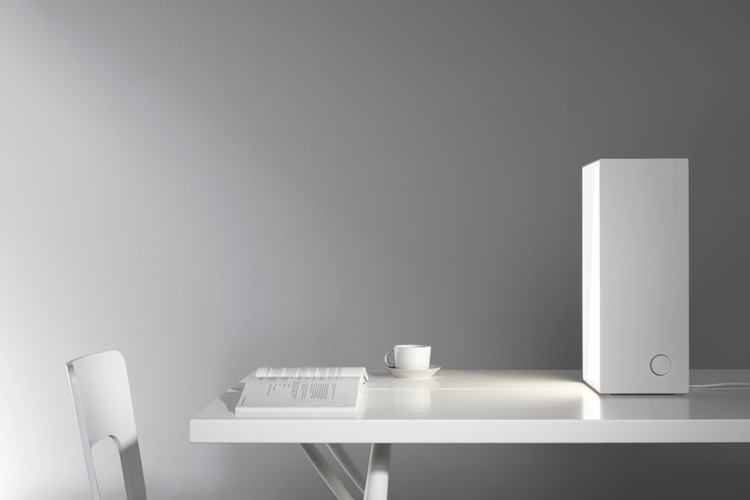
Kokkonen, to his credit, pushes his design philosophy to the limit -- even into metaphysical territory. "Right from the beginning of the design process we felt that there would be room for a lamp that allows light to rule," he
writes. "The biggest tribute for 'White' would be that people remember its soft light but have no idea how the lamp itself looked."
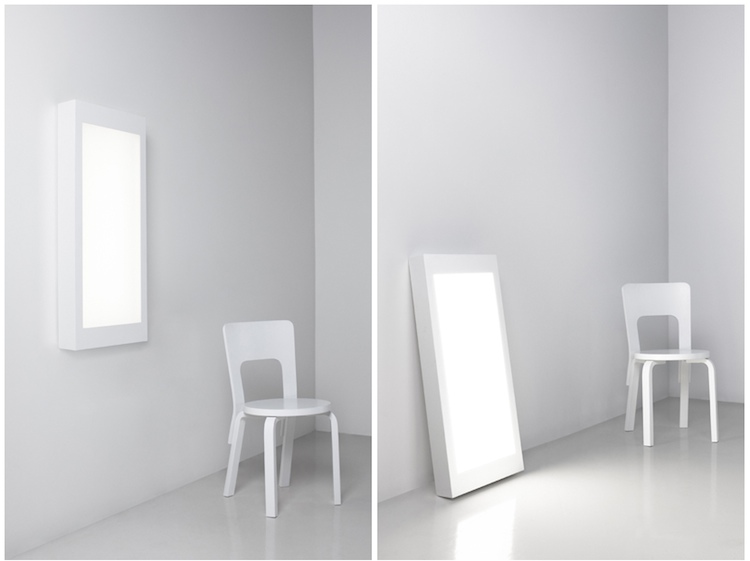
A lamp so pure that you literally can't even remember anything about it but the light itself? Quite a tall order, unless Kokkonen has installed
one of those mind-wiping doodads from Men In Black inside his fixtures. But we appreciate the ambition, as well as the sheer beauty of his designs.
[Read more at DesignBoom | Photos by Tuomas Uusheimo]
Milan Preview: Kartell's New Disappearing Furniture
by: Co.Design, 2011-04-04 15:18:26 UTC
With the 2011 Milan Furniture Fair just weeks away, our inboxes are filling up with breathless press releases on groundbreaking chairs! Revolutionary couches! Mind-bending dish racks! So far, though, everything's been pretty... meh.
One glowing exception:
Tokujin Yoshioka's new Invisibles Light series for
Kartell, which looks like a furniture set sprung from the hands of Houdini.
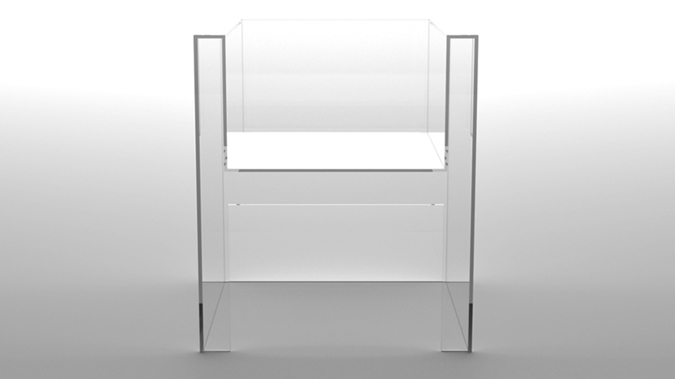
This isn't the first time we've described Yoshioka's work that way. Yoshioka, who hails from Japan, is a master of illusion -- a genius who can turn ordinary materials from
glass to
plastic to
bird feathers (!) into extraordinary, otherworldly designs.
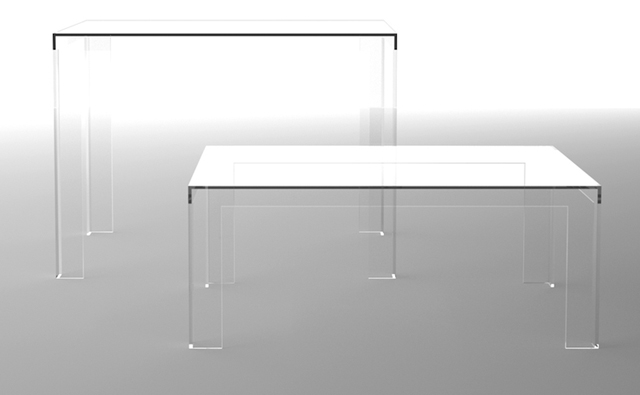
Here, he used acrylic to make chairs and tables the objects of a domestic disappearing act. More precisely, he combined the material with ur-minimal forms -- note the complete absence of obtuse and acute angles -- to create furniture that appears, from certain perspectives, as less of something you'd actually sit in than a 2-D line drawing you'd hang on the wall.
[Images courtesy of Tokujin Yoshioka]
Fashion Conglomerate PPR Group Launches Sustainability Plan for Gucci, Puma & More
by: Inhabitat , 2011-04-03 15:36:57 UTC

PPR Group — the parent group behind high-end labels like Gucci, Puma, Yves Saint Laurent, and Stella McCartney — is fast on its way to becoming the sustainable trendsetter of the future. The group recently launched PPR Home, a major sustainability plan in order to offset its entire 2010 footprint, an estimated 98,729 tons of carbon. With an annual budget of more than $14 million and a multinational platform, PPR Home has the potential to change the way we think of sustainability and fashion. Read on for all the details.
Permalink |
Add to
del.icio.us |
digg
Post tags: Gucci, ppr group, ppr group green initiative, ppr group green plan, ppr group sustainability plan, ppr home, PUMA, Stella McCartney, Sustainable Fashion, sustainable trendsetter
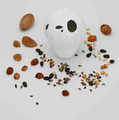
Comments by our Users
Be the first to write a comment for this item.